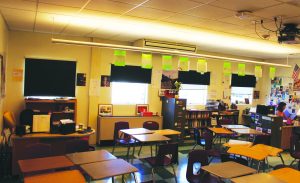Look around you. Do your classes feel larger than last year? Are the hallways more crowded? Are there multiple teachers in your classroom? Do you have to plan strategic bathroom breaks to avoid the lines? Is your teacher frazzled between periods?
Welcome to the increasingly populated Redwood High School, which has a total of 1,802 students this year. Principal David Sondheim anticipates this growth will be an ongoing trend.
“Our projections indicate [that] we expect to grow from just about 1,800 [students] this year to over 2,100 in four years from now,” said Sondheim.
The higher enrollment is primarily due to the larger local population, according to Sondheim. More students need more teachers, resulting in a school population that is stretching both facilities and teachers’ resources thin.
One of the biggest challenges for teachers is the need for shared classrooms, something that has become increasingly common over the last five years.
“We are definitely getting more and more crowded and are nearing 100 percent room utilization,” Sondheim said.
There are benefits of sharing a classroom, such as more teacher interaction and greater appreciation for colleagues’ teaching styles, according to Ippolito and social studies teacher Lisa Kemp.

But the drawbacks of sharing a classroom can be significant. Ippolito’s crunch time is between third and fourth period, when he faces difficulties preparing for his fourth period class.
“I have to log the [former] teacher off the back computer and get all set-up, log on, get my Powerpoint up and get my market screens up, get everything ready, and I have five minutes,” Ippolito said.
Rotating through more than one classroom during the day compounds the logistical issues teachers face. Different classrooms have different supplies or equipment and teachers must carry their teaching materials between multiple classrooms over the course of the day.
Kemp has had to run up and down stairs between classrooms when the internet and a projector in her existing classroom failed to work. She didn’t know they were broken because she had just started using the classroom.
The transition from one classroom to the next can be even more stressful in science classes, as many are taught in a lab format, according to Doherty. Teachers must coordinate labs, chemical preparations, set up and clean up.
“We have pretty much lost our lunch period if you’re moving from a fourth period class to a fifth period,” Doherty said. “It’s a really good day if you get to eat lunch and you get to go to the bathroom.”
Doherty and Kemp stated that these challenges require them to be more organized and flexible. If teachers need an item in another classroom, they must wait to retrieve it.
“Too many teachers [are] wasting time because we don’t have a good place to go and get work done, or we left something in a classroom that we need and we don’t want to go in and disrupt a class to get it,” Ippolito said.
Another issue is the lack of space to prepare for lessons and meet with students, according to Ippolito and Kemp.
“Very few teachers I know have their prep period in their classroom,” Ippolito said. “Usually you see a lot of teachers in the copy room. Sometimes we have three teachers in this tiny little office trying to do work during their prep period. It definitely makes it more difficult.”
Kemp expressed a similar opinion, noting that she shares an office with several faculty members. During their free period and when the computers are slow, it can be particularly challenging to get work done.
“There are very few quiet spaces to work,” Kemp said. “It’s really a bummer not to have someplace to meet with kids that’s quiet.”
As classroom size rises, keeping control inside the classroom is especially important, according to Ippolito.
“I have no tolerance for cellphones or disruptions. With 30 kids, I can’t afford to let kids cross talk,” Ippolito said.
The stress on facilities is being felt by clubs as well. Kemp noted that the club she advises, Model United Nations, is having a harder time finding places to meet. She explained that they would like to meet in her classroom, but it is already being used at lunch by another teacher who is meeting with their students.
Some teachers, such as Ippolito, wonder about the administration’s plans to address this growing concern. Portable classrooms were mentioned by Kemp and Ippolito as a potential solution.
The administration has acknowledged the problem and plans to research various solutions.
“We will be looking at ways to house additional students over the next several years,” Sondheim said. “One of our challenges ahead is how to provide the excellent service that we’ve provided for our students for so many years.”

















